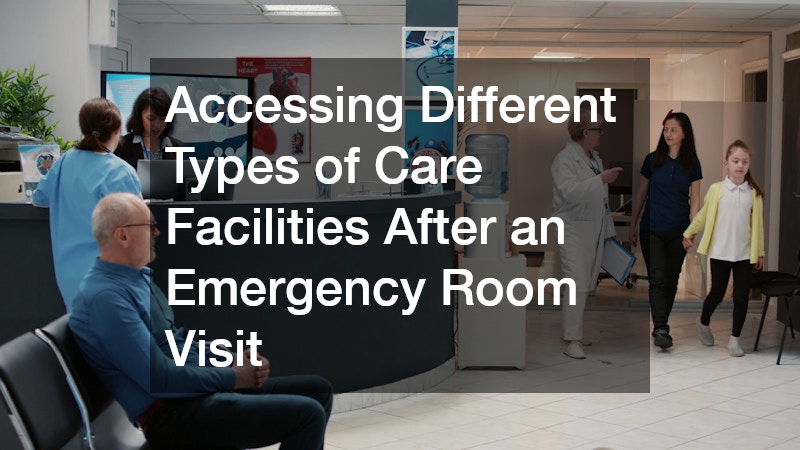After an emergency visit, patients often face the critical decision of what comes next in their recovery journey. Leaving the hospital or urgent care setting does not always mean a return to complete independence immediately. Instead, many individuals require additional support, specialized treatments, or structured environments to continue their healing process. Understanding the types of care facilities available for ongoing recovery is vital to ensure the best possible outcomes for recovery, whether the focus is on regaining mobility, managing chronic conditions, or receiving specialized treatments.
There are numerous types of care facilities designed to meet a wide range of patient needs following an acute medical event. These facilities can offer everything from intensive therapy programs to more relaxed environments focused on restoring daily function. For patients and their families, knowing what each type of care setting provides can simplify decision-making and help align treatment plans with personal recovery goals. This knowledge also reduces the stress that often accompanies a transition from a highly medicalized environment to one centered on rehabilitation and support.
This article will guide you through the most common types of care settings you may encounter after leaving an emergency department. From specialized clinics focusing on particular medical conditions to centers designed for physical strengthening and therapy, we’ll cover what you need to know. We’ll also look at alternatives to facility-based care, including options that provide professional support at home.
By the end of this guide, you will have a clearer understanding of the various care environments available post-emergency visit. This will empower you or your loved ones to make informed choices that promote healing and long-term well-being.
1. Next Steps After ER
When a patient leaves the emergency room, their journey to recovery is just beginning. The initial urgent care addresses immediate medical needs, but ongoing recovery often requires additional support. Understanding the different types of care facilities available after discharge is crucial in determining the best path forward. These facilities offer structured environments where patients can receive specialized attention, therapies, and monitoring tailored to their unique health needs.
The transition from the emergency setting to the next stage of care involves assessing the patient’s physical condition, mobility, and medical stability. Healthcare professionals evaluate whether a patient can safely return home or if a more intensive recovery environment is necessary. Often, this decision is based on the severity of the condition treated in the emergency room and the anticipated recovery time. This step is essential because it ensures patients receive the appropriate level of care without risking setbacks.
These different settings can range from short-term recovery centers to specialized clinics focused on particular health issues. Each facility type has unique resources and staff expertise designed to address various stages of healing. Coordination between hospital teams and post-discharge care providers helps streamline this transition, making sure patients move smoothly into environments that support their rehabilitation goals. Recognizing these options early can significantly impact the recovery experience.
2. Starting Your Recovery

Beginning the recovery process after an emergency visit involves engaging in therapies designed to restore function and independence. Rehabilitation therapy plays a vital role in helping patients regain strength, coordination, and skills lost due to injury or illness. Different types of care facilities offer access to these therapeutic services, which are tailored to individual needs to optimize recovery outcomes.
Rehabilitation therapy programs are often provided in dedicated centers where multidisciplinary teams work together to create customized treatment plans. These programs might include physical therapy, occupational therapy, and speech therapy, depending on the patient’s condition. The availability of comprehensive therapy options within a single facility allows for coordinated care that addresses multiple aspects of recovery simultaneously.
Rehabilitation therapy is not a one-size-fits-all solution. The intensity, duration, and type of therapies vary widely, depending on factors such as the patient’s age, diagnosis, and overall health. Facilities offering these services typically assess progress regularly and adjust treatments accordingly. This adaptive approach helps patients regain independence as efficiently as possible, improving both short- and long-term health outcomes.
3. Choosing Care Facilities
Selecting the right care facility after a hospital visit is a critical decision that influences recovery quality and speed. There are many different types of care facilities, each designed to meet particular patient needs, ranging from intensive rehabilitation centers to more supportive environments. Understanding the offerings and specialties of these centers helps families and patients make informed choices.
Rehab centers vary in the range of services they provide, the level of medical oversight, and the types of therapy available. Some centers focus on intensive physical recovery, while others may specialize in neurological rehabilitation or chronic disease management. Choosing a facility involves considering factors such as location, staff qualifications, available therapies, and insurance coverage to find the best fit.
The process of selecting a rehab center often involves consultations with healthcare providers, tours of potential facilities, and reviewing patient outcomes and satisfaction ratings. It is important to weigh the intensity of care against the patient’s personal preferences and lifestyle to ensure both medical needs and emotional well-being are addressed. A well-chosen center can make a significant difference in the recovery trajectory.
4. Types of Therapy Available

When recovering after an emergency visit, patients may encounter a variety of options for rehab therapies designed to restore different aspects of their health. The types of care facilities offering these therapies provide tailored programs that focus on specific functional goals. Understanding the range of therapy options available helps patients and families identify the most suitable approach for recovery.
Therapy programs can include physical, occupational, speech, and other specialized treatments. Each therapy targets different needs—physical therapy helps improve movement and strength, occupational therapy assists with daily living skills, and speech therapy addresses communication or swallowing difficulties. These services are often coordinated within care facilities to provide comprehensive rehabilitation.
Many care settings offer integrated therapy plans where professionals collaborate to address multiple areas of recovery simultaneously. This multidisciplinary approach enhances the patient’s ability to regain independence and quality of life. The availability and intensity of therapies vary by facility type, which is why knowing the specific offerings is essential when selecting a care environment.
5. Local Rehab Options
Finding a nearby facility dedicated to recovery can make a significant difference in a patient’s healing process. Local rehabilitation therapy clinics provide accessible services that support ongoing recovery after an urgent hospital visit. These clinics serve as an important bridge between inpatient care and returning to everyday activities.
These clinics often offer outpatient services, allowing patients to receive therapy sessions without the need to stay overnight. This setup is particularly convenient for individuals who are medically stable but still require structured rehabilitation to regain strength and function. Being close to home also encourages family involvement and consistent attendance.
Local clinics typically provide personalized therapy plans with flexible scheduling to accommodate patients’ lifestyles. They may specialize in certain types of rehabilitation therapies or offer a broad range of services. Access to local facilities promotes continuity of care and helps patients gradually transition back to normal routines while still receiving professional support.
6. Regaining Strength
After an emergency medical episode, rebuilding physical strength is often a central goal of recovery. Physical rehabs are specialized facilities focused on helping patients regain muscle tone, balance, and endurance through targeted exercise and therapy programs. These environments provide the structure and support necessary for patients to safely improve their physical abilities.
Physical rehab programs are tailored to individual needs, addressing the effects of injury, surgery, or illness. Patients work with licensed therapists who design exercise regimens that improve mobility, reduce pain, and enhance overall function. The facilities are equipped with tools and technology to assist in various stages of physical recovery.
They often emphasize patient education, teaching techniques to prevent future injuries, and promoting long-term health. Progress is closely monitored, and programs are adjusted to meet evolving needs. These care centers play a vital role in helping patients return to their daily lives with greater confidence and physical independence.
7. Specialized Vascular Care
Certain health issues require specialized care centers that focus on specific medical conditions. Vascular clinics are examples of facilities dedicated to diagnosing and treating blood vessel disorders. Patients with circulatory system concerns often benefit from the expertise and advanced treatments available at these specialized centers.
Vascular clinics offer comprehensive evaluations, including imaging tests and diagnostic procedures, to identify issues such as blocked arteries or venous insufficiency. They provide treatments ranging from medication management to minimally invasive procedures. These clinics play a key role in preventing complications and promoting vascular health during recovery.
These clinics often collaborate with rehabilitation teams to support patients who need therapy related to circulation problems. Coordinated care between these specialists and rehabilitation providers ensures that patients receive targeted interventions that address both vascular health and overall recovery goals. Access to such focused care facilities is crucial for certain patient populations.
8. Therapy for Mobility

Regaining mobility after an acute medical episode is essential for returning to independent living. Care facilities offering physical therapy services are equipped to help patients improve movement, strength, and balance through customized treatment plans. These services are integral components of the broader landscape of recovery options.
More specifically, physical therapy services involve exercises and techniques that enhance muscle function, joint flexibility, and coordination. Patients may work one-on-one with therapists who guide them through progressive activities designed to restore function. Such services are available in various settings, including outpatient clinics, rehab centers, and sometimes in specialized hospital units.
Physical therapy programs are adaptable to the patient’s changing condition. They provide frequent assessments to measure progress and modify treatments. The emphasis is on enabling patients to safely resume daily activities and reduce the risk of future injury. Facilities providing these services are critical parts of the continuum of care after an emergency medical event.
9. Short-Term Care Help
After a hospital stay, some patients and their families need temporary relief from caregiving responsibilities. Facilities offering short-term care provide a valuable service by allowing caregivers to rest while ensuring patients receive quality support. This type of care plays an important role in the broader system of post-acute recovery.
More specifically, respite care settings offer short durations of care in a safe environment, which can range from a few hours to several weeks. These facilities are staffed by trained professionals who provide medical monitoring, assistance with daily activities, and emotional support. This temporary care helps prevent caregiver burnout and supports patient well-being.
In greater detail, respite care is often used as a bridge when transitioning between different types of care facilities or when family caregivers need a break. These services are tailored to meet individual needs and can be arranged in a variety of settings, including specialized centers or even at home. Recognizing the availability of short-term care options expands the possibilities for managing recovery effectively.
10. At-Home Support Services
For many patients, recovering in the comfort of their own home is an appealing alternative to moving into a facility. At-home support services provide professional care and assistance tailored to individual needs without requiring relocation. These services are an important option within the spectrum of types of care facilities and support available after an emergency visit.
Home care companies offer a range of services, including personal care, medication management, and sometimes therapy visits. This option allows patients to maintain their daily routines. They can also remain in familiar surroundings while receiving the professional help necessary for recovery. It also offers flexibility in the level of care, from a few hours per day to around-the-clock assistance.
Home-based care can be coordinated with other healthcare providers to ensure continuity and comprehensive management of recovery goals. This option can reduce hospital readmissions and support long-term independence. For many families, the availability of home care services provides peace of mind knowing their loved one is supported in a comfortable and personalized setting.
The Path to Recovery
Navigating the path to recovery after an emergency room visit involves understanding a variety of care options tailored to different needs. The types of care facilities available encompass a broad range of services, from intensive rehabilitation centers to specialized clinics, short-term respite care, and at-home support. Each option provides unique benefits depending on the patient’s medical condition, personal preferences, and recovery goals.
Choosing the right facility is crucial to promote effective healing and regain independence. Understanding these types of care facilities helps patients and families make informed decisions, aligning care environments with individual recovery requirements. Coordination between healthcare providers and post-discharge facilities ensures seamless transitions and comprehensive care plans. This collaborative approach improves outcomes, reduces the risk of complications, and enhances overall quality of life.
After an emergency visit, exploring all available care options is essential. Whether the need is for specialized therapies, temporary relief for caregivers, or support within the home, the variety of care settings offers pathways suited to diverse needs. By leveraging this knowledge, patients can access the most appropriate services to support their healing journey and return to their daily lives with confidence.




